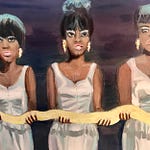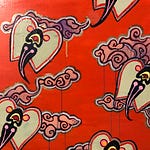“It's real hard to be free when you are bought and sold in the marketplace.."
— Dialogue from ‘Easy Rider’
There are a lot of myths and misconceptions about what happens to fashion during times of political turmoil. That old “hemline index” chestnut, for starters, is apocryphal - skirt lengths don’t rise and fall over time in any discernible fealty with the stock market (and this is disappointing.)
However: after watching politics and fashion evolve through several drastically different presidencies, and studying fashions around America the last several years, I believe there may be a discernible link between fashion and politics. The canary in the coalmine by which we can really see the effects of politics through fashion, I think, may be subculture.
If we flip through the 1900’s in broadest strokes, we may begin with the 1920’s, and the driving political issue of Prohibition.
Fun-seekers were driven underground to enjoy a bit of hooch, and so invented the speakeasy. A wild new flock of Flappers cut their hair and girdles off, to better enjoy getting squiffy and doing the Lindy Hop to the forbidden sounds of Negro Jass music (until the cops raided the joint, or the gangsters shot it up.)
Subcultures in the 1930s were largely starved out by the Depression and the Dust Bowl…(but, on the bright side, the Rhumba was born; as was Frank Sinatra’s iconic mug-shot).
Perhaps the most notable subculture skirmish of the 1940’s was the Zoot Suit riots. White WWII servicemen stationed in Southern California became enraged at the sight of young Filipino, black, and Mexican-American men wearing overlong Zoot Suits with high-draped pants and snappy pork-pie hats. These noble servicemen (soon joined by voluntary groups of white vigilante bigots) took it upon themselves to regularly beat and strip young men of said Zoot Suits, and burn their suits in public. These atavistic acts of fashion criticism were vindicated by white news reporters and politicians, who argued that the Zoot Suit was “a badge of hoodlumism” — an indicator of imminent violence, suggestive of crimes like gambling and numbers-running, and also symbolic of a grievous, insult to our nation, in that the use of extra cloth required for the oversize Zoot-cut was profoundly “unpatriotic” — an open, disrespectful flouting of Wartime fabric rations.
After the LA City council criminalized the wearing of Zoot Suits within city limits, the riots spread: within weeks, Zoot Suit battles were being fought in Texas, Arizona, LA, New York and Detroit, ultimately resulting in the brutal beating and incarceration of over over 500 young (nonwhite) Zoot-Suiters on charges as vague as “rioting” and “vagrancy.” White-run newspapers went so far as to claim the unprovoked attacks produced a “cleansing effect” to the local areas terrorized by the wearing of Zoot Suits.
Eleanor Roosevelt almost explained the deeper issue behind the haberdashery-bashings: ”The question goes deeper than just suits. It is a racial protest.”
What she did not articulate was that Zoot Suits were infuriating to white authorities precisely because minorities felt good and empowered in them; the suits were stylish, hip, and smart and conveyed unto the wearer something unforgivably dangerous like fun, pride or self-esteem.
Interestingly enough, a mere three years later, the exact same subculture crime against America was committed again.
This time, it was 1947. Wealthy women had grown bored of observing the severe austerity measures of wartime, and no longer felt compelled to dress down in solidarity with their austerity-laden countrywomen. They felt a sudden drive to damn the rations and indulge a transgressive weakness for vanity and opulence again.
Enter: The House of Dior, and its legendary, controversial New Look.
In a letter from 1947, Nancy Mitford wrote that while wearing the New Look, “people shout ordures at you from vans because for some reason it creates class feeling in a way no sables could.”
(Surprisingly enough, bloodthirsty vigilante mobs of bigots, police and the Navy did not descend on Madison Avenue with to beat down, strip and imprison Manhattan socialites for their un-American dress activities.)
Middle class women, however, were thrown into snits: for them, the Dior New Look wasn’t just unpatriotic — it contained such voluptuous excesses of exclusive fabrics that they were completely beyond their economic grasp. Middle class ladies felt severely shown up.
This, I believe, was the main psychological hook at the heart of the New Look.
Culture industries were just beginning to become adept at manipulating society into self-maintaining the status quo by dividing and conquering communities through such subtle tools of class warfare as luxury fashion. Building little apartheids and exaggerating class differences through small token belongings packed with symbolic class violence made it easier to divide communities. They were little wedges that led to larger self-segregation and differentiation. Largely unaffordable luxuries were quiet little dye-bombs that clearly distinguished Us from Them, and Haves from Have Nots.
In the 1950’s, the wacky, literate Beatniks took America on a wild bus ride, to explore coffee houses, folk music and black turtlenecks. They recited poems in tattered workwear decrying the scourge of materialism. They prized intellectualism, and made it cool to bat around buzzwords like “counterculture,” “nonviolence,” “anti-authoritarian,” “anti-establishment,” and tangy kickers like “equality” and “peace.” The Beatniks were a white fashion tribe that resembled minority fashion tribes; it collected around shared socio-political values of liberty and egalitarianism that stood directly opposed to the agencies of state oppression.
From the heads of Beatniks, the Hippies rose, fully-formed in the 1960’s and shocked the bourgeoisie by embracing such forbidden exotica as free love, black music, eastern spirituality.
While it is hard to believe today, being a man with hair below the collar in the 1960’s was openly defiant; a statement bold enough for you to potentially get your ass kicked, daily. Long hair was an open declaration of a distinct set of explicitly counterculture values. Your hair wasn’t just hair: it was your anti-war, anti-establishment, anti-materialism, anti-racist, anti-sexist-battle flag.
Time magazine’s cover story about San Francisco’s Summer of Love in 1967 immortalized the braless, love-beaded Flower Children, and made their peasant tops, granny-glasses and lysergic rapture a recognizable archetype.
“Blow the mind of every straight person you can reach,” said a Hippie in the article, reciting the specific philosophies of his Hippie tribe. “Turn them on, if not to drugs, then to beauty, love, honesty, fun.”
Many other important subculture rebellions took place in the decades to follow:
Drag Queens pushed to riot at Stonewall, and gained their right to exist. Glam rock from across the ocean persecuted a terrifying assault on old-school homophobia by gender-bending nubile boys and girls into the same gold leather pants. Punk actually happened, for a minute (and was quite quickly afterward co-opted to death on the runways of high fashion).
During the 1980‘s -- another era when Wall Street insiders were openly and unapologetically raping the economy — fashion ushered in the Armani Power Suit, and brought the ‘Rich Bitch’-look back into Vogue (largely, one presumes, due to the success of the power hair, cellophane gowns and chandelier diamonds of DALLAS). These brazen looks took the class offenses of the Dior New Look to a whole new class of hotel. The fashion of 80’s money didn’t just flaunt wealth so much as intentionally stab stiletto-heels repeatedly into the middle-class groin with sadistic joy and vigor. The super-rich, at that point in time, seemed to have a collective shift in groupthink: a decision was made in the collective brain of the wealthy they would never apologize nor feel guilty again for being obscenely rich, no matter how many ex-spouses they’d ice-picked to get it.
By the time the nineties gave us the heroin-chic of Seattle grunge, the time it took for a legitimate counterculture fashion to get kidnapped, co-opted, denuded of all political subtext, rebranded and thrown onto a Paris runway had collapsed down to the speed of technology. More or less the exact moment an eye-catching new subculture fashion arose, it was sucked backward, rebuilt, thrown into a vat of acid until all the symbolic meaning bleached out —then slapped onto Naomi Campbell and trotted onto the runway paired with a $6000 hobo-bag.
In the spring of 2011, toward the end of my stint as an NYT Critical Shopper, I was assigned to review the then-new Dior flagship.
( Please forgive me if you’ve read some version of this story before. )
At first glance, the new Dior resembled like a Barbie Townhouse, if Barbie had become one of Vladimir Putin’s six identical blonde wives, and Putin had become a Liberace/Hugh Hefner hybrid. It was a castle to vanity wrought in silver and white mirrors, reflecting giant videos of models walking in the current season of styles: giant blonde domes of doll hair millions of frilly pink and yellow bows — all the gingerbread and pastels of a Disney princess who never grew up but was more than ready for her magical virgin wedding night.
One of the store attendants knew who I was. As a favor, he snuck me into a special closet to show me a piece he was very exited about. Once the door was closed, he carefully unwrapped a strapless, ruched black lambskin dress from its special tissue coccoon.
“I can let you try it on, but it’s a secret: Melania Trump just bought it this morning!”
This was, of course, was an experience too fascinating to resist.
And so, once alone, I stripped down and stepped into Melania Trump’s new princess play-dress - a perverse leather quinceañera-sacrifice gown; equal parts child, whore and Eyes Wide Shut-ness. The shape of Melania’s bust was still pressed warmly into the bustier. Her cloying perfume evoked a cocktail made with fruit-infused cognac and Mr. Bubble. I zipped the dress, felt its regal weight, and noticed, with some awe and trepidation, that this black dress was something like standing in a magnolia composed of hundreds of hand-pintucked petals made from the blackened skin of baby lambs. It was a mind-boggling piece; it held my body like the hands of a lover. It was a very, very, flattering piece of exquisite couture, and I felt a raw, nearly overpowering urge to throw up on it.
I had been hanging around on Madison Avenue trying on outrageous clothing for several years — but that particular dress (which I believe was somewhere in the $30-$40,000 range)….was not justifiable in any context of the world I had ever seen. The attendant wanted me to come out of the room and swirl around in it - and as much as I liked him, I just couldn’t.
The excess of it was so vital - such a visceral insult, all I could think about when I scrambled to get it off my body was my sister, who, despite her college degree, was living like an immigrant: waiting for 6 hours in the emergency room to get medical attention for her sick babies. The predatory PayDay loan she took out in desperation to make her car payment - the daily humiliation she put up with from hairdo hippies in grocery stores all the time when she annoyed them with her food stamps.
That dress was the most symbolically potent clothing item I had seen in years: It yowled and gloated and sneered racial epithets; it was, and wanted to be, everything evil and unfair and unbalanced on planet earth that said “Fuck You, I am WEALTH, and you are NOT.”
In the Times, I summarized the Dior aesthetic as “A whorish criminal rococo for ethical zombies, entrepreneurial land sharks and hookers, made deliberately to adorn mistresses and new trophy wives in the sartorial equivalent of hula skirts made from 500-euro notes…Not to put a peasant in the punch bowl, but Dior would make an ideal costume department for the Vlad Putin Hollywood vehicle, 'Kremlin, Inc.: Too Fast, Too Furious.' Moscow, after all, does not believe in understated elegance.”
Then, six years later, that dress was in the White House.
One cover of VOGUE a few years ago featured a pack of Kardashian women, standing with their legs cutely entwined on a beach in matching short-shorts. One of the sluglines underneath echoed a sentiment I have been hearing over and over now for at least 10 years now: “THE BEAUTY REVOLUTION: No Norm is the New Norm.”
Fashion’s complete and utter failure to bother to define itself anymore is upsetting to me for various reasons, but my biggest complaint is this:
Fashion has always been a vehicle for individual socio - political commentary - but finding a counterculture style that can send an actual message is is a lot harder now.
When Rupert Murdoch is photographed on a Harley — when the “outlaw biker” subculture that has fought so hard to resist conformity since the late 1940’s winds up morphing into a tear-away leather codpiece on a network soap-opera like “Sons of Anarchy” — it means that the suits, for now, have won the culture war. They have simply decided there is no subculture; no garment or haircut which can instantly convey a complex message of outrage or rebellion or even Flower Power — because all style has been codified, mapped, described, and the value of all fashion symbols has been neutered to the point of invisibility. If all the tribal markings of all outlaws have been rendered symbolically meaningless and turned into mid-range sportswear— nothing wearable can express anything.
There is, however, one notable, if somewhat regrettable, exception:
that floppy-flat-pom-pom; that sandwich bag of knobby pink yarn embraced by the feminist head: the plucky, homely, brave little Pussy Hat.
(No, it ain’t sanculottes drag…and it was fucking horrible fashion. But it was a start.)
Deciphering your own style-code — finding your own keys to your next deliberate evolution as an individual through personal style - gives others in your tribe permission to enjoy this exercise themselves. Style is viral, and as positively contagious as good jokes or slang. It’s a pleasure skill that can’t be removed or repressed. It is always possible, even in the most extreme poverty - even while incarcerated - to find something - anything - even a dishtowel - that you can shape into a turban with a rubber band and a zip-tie — something you can do that will magically lift your mood, and allow you to hold your head a little higher.
Ignore the barking threats and the content-free information. Go find your magic turban. Be the example that grants your community permission to transform. With an unshakable will to beauty, you always have the power to invent, and reinvent glamour out of anything, anywhere, always.














Share this post